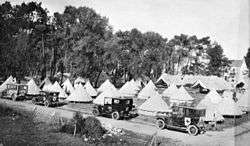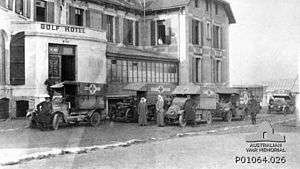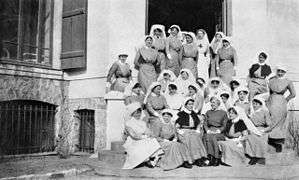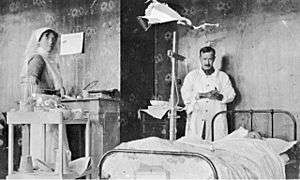Australian Voluntary Hospital
The Australian Voluntary Hospital was a military hospital staffed by Australian expatriates in England that served on the Western Front between 1914 and 1916. For much of this time it was the only Australian presence on the Western Front.
| Australian Voluntary Hospital | |
|---|---|
 Australian Volunteer Hospital, St Nazaire, France, 1914 | |
| Active | 1914–1916 |
| Country | |
| Type | Medical |
| Size | ~120 officers and men |
| Engagements | World War I |
Origin
When the First World War broke out in August 1914, Lady (Rachel) Dudley, the wife of the former Governor-General of Australia, the Lord Dudley, decided to create a hospital from Australian doctors and nurses who were in the United Kingdom. There were relatively large numbers of these; while doctors and nurses could be trained in Australia, advanced qualifications still required a trip overseas.[1]
Lady Dudley discussed her proposal with King George V, and then with the Secretary of State for War, Lord Kitchener, and the British Army's Director General Army Medical Services, Sir Arthur Sloggett, who authorised the hospital. The hospital was formally offered to the British government by the Australian High Commissioner to the United Kingdom, Sir George Reid on 15 August 1914.[2] Volunteers responded to advertisements that Lady Dudley placed in English newspapers on 17 August 1914. Women doctors were not accepted, but women nurses were welcomed.[1]
The Australian Voluntary Hospital was commanded by Lieutenant Colonel William L'Estrange Eames, an officer in the Australian Army Medical Corps who had served in the Second Boer War, and was holidaying in England with his family at the time.[3][4] He was unable to join the Australian Imperial Force (AIF), which was not accepting enlistments outside of Australia.[5] He was granted the temporary rank of lieutenant colonel in the Royal Army Medical Corps. Ida Greaves, from Royal Newcastle Hospital, was appointed matron. The hospital soon reached a strength of 120 staff, of whom 36 were nurses.[1]
Operations
The Australian Voluntary Hospital assembled its personnel and equipment at a camp established on the grounds of the Ranelagh Club, which had been loaned for the purpose. It departed for France on 29 August 1914 on Lord Dunraven's yacht "Greta", which had been accepted by the Admiralty as a transport for medical units,[2] and moved to Le Havre. Owing to the German advance, the hospital was evacuated to St Nazaire on 2 September, and reopened there 5 September. The 100-bed hospital was set up in a park under canvas, with a school and house close by rented for various facilities. It began receiving casualties from the retreat from Mons the next day.[1]
On 26 October 1914, the Australian Voluntary Hospital moved to Wimereux, where it established a 200-bed hospital. The hospital was well equipped, with motor ambulances donated by organisations in Australia, a pathology laboratory and the only X-ray unit in the area. A day after it opened on 29 October, it began receiving patients from the First Battle of Ypres.[1] Much of the unit's tents which accommodated the male personnel of the hospital were lost in a blizzard on 11 November 1914, and the men moved to the Golf club house of the Hôtel du Golf et Cosmopolite in Wimereux, which was eventually leased by the hospital, and became its officers' mess.[2]
For a time, the Australian Voluntary Hospital was the only Australian presence on the Western Front, but in April 1916, Australian Army units began arriving from the Middle East in large numbers. The Australian Voluntary Hospital's site in Wimereux was taken over by No. 3 Australian General Hospital, AIF in June 1916. The Australian Voluntary Hospital was then absorbed into the British Army as No. 32 Stationary Hospital,[6] with Eames remaining in command.[1] By 1 May 1919, the hospital had treated 73,868 patients.[2]
Gallery
 Ambulances outside the Australian Voluntary Hospital at the Hôtel du Golf et Cosmopolite in Wimereux. The ambulances carry signs indicating their donors, such as the "Red Cross Society, Queensland"
Ambulances outside the Australian Voluntary Hospital at the Hôtel du Golf et Cosmopolite in Wimereux. The ambulances carry signs indicating their donors, such as the "Red Cross Society, Queensland" Nursing staff of the Australian Voluntary Hospital. Matron Ida Greaves is at the front, fourth from the left
Nursing staff of the Australian Voluntary Hospital. Matron Ida Greaves is at the front, fourth from the left Staff Nurse May Miles and Captain R. V. MacDonnell tend to a patient
Staff Nurse May Miles and Captain R. V. MacDonnell tend to a patient
Notes
- Ray, Pam (April 1991). "A Photographic Record of an Australian Nursing Sister". Journal of the Australian War Memorial (18): 63–65. ISSN 0729-6274.
- The History of the Australian Voluntary Hospital, manuscript, pp. 1–7, Australian War Memorial: 1 DRL 667 12/11/1147
- Horner, David (1981). "Eames, William L'Estrange (1863–1956)". Australian Dictionary of Biography. 6. Melbourne University Press. ISSN 1833-7538. Retrieved 12 July 2013 – via National Centre of Biography, Australian National University.
- Bean 1929, p. 161.
- Butler 1930, p. 492.
- Butler 1930, p. 497.
References
- Bean, Charles (1929). The Australian Imperial Force in France 1916. Official History of Australia in the War of 1914–1918. Volume III. Canberra: Australian War Memorial.CS1 maint: ref=harv (link)
- Butler, A. G. (1930). Gallipoli, Palestine and New Guinea. The Official History of the Australian Army Medical Services in the War of 1914–1918. Volume I. Melbourne: Australian War Memorial. OCLC 156690674.CS1 maint: ref=harv (link)